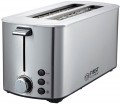Power
Electrical power consumed by the device during operation. A more
powerful appliance spends less time cooking to readiness; at the same time, the high consumption of electricity is often offset by the speed of cooking (in other words, the device simply does not have time to "eat" a lot of energy). However, such a device will also cost more. Therefore, it makes sense to specifically look for such a technique mainly in cases where “every extra second matters” — for example, if a toaster is bought for a cafe or diner where you need to cook quickly and in large quantities.
Also note that a device with a large capacity will inevitably require a higher power.
Number of products
The maximum number of individual products that can be cooked in the appliance at the same time.
For toasters, this parameter corresponds to the number of standard rectangular pieces of bread that fit into the device. Accordingly, if the size of the blanks used differs from the standard, then the capacity may be more or less than the claimed one.
If we are talking about a waffle iron, cake-pans or other device of a similar design (see "Type"), then the number of products is usually indicated by the number of notches on the working surface. In this case, note that the larger the capacity, the smaller the size of each product (especially since the working surface area for different models does not differ so much).
Control
The type of control provided in the device.
-
Mechanical. Mechanical systems are systems in which the control elements are connected to the working elements of the device directly, without the “mediation” of electronic circuits. For example, the power button in such models directly closes and opens the power circuit, the rotary knob of the thermostat rotates the rheostat, which changes the current strength in the heater, etc. Such control, which is mainly implemented by a rotary switch, is simple, reliable and at the same time low cost. True, it does not allow the implementation of some functions and is not particularly accurate in adjusting individual parameters (timer settings, heater temperature); however, in the case of these shortcomings often turn out to be insignificant. Therefore, most of these devices nowadays use this type of control.
-
Push-button. Push-button control is based on electronic circuits. Such systems are more accurate than mechanical ones; more capabilities and modes are provided. On the other hand, such control is more complex and more expensive than mechanical control.
-
Touch. A type of
electronic control with touch switches. Compared to push-button models, it provides a high level of comfort in operation, and looks more modern and aesthetically pleasing.
Features
—
Auto-centering. Function found in toasters (see "Type"). Thanks to auto-centering, each slice of bread is placed in the centre of the compartment during cooking, at the same distance from the heating elements, and toasted on both sides equally.
—
Heating. Operating mode of the toaster (see "Type"), in which the product is not fried, but only slightly warmed up. This function can be useful, for example, to reheat previously cooked toast.
—
Defrosting. Toasters often include a specialized function, found in their features (see Type), for toasting frozen bread. Frozen bread cannot be directly fried, as it requires defrosting first. The toaster's defrost mode provides a convenient way to defrost frozen bread quickly and efficiently.
—
High lift. Possibility of lifting cooked toast above the standard height. This feature is useful when toasting small slices of bread that would otherwise be difficult to remove from a hot toaster.
—
One-sided frying. Possibility to toast on one side only. This function can be useful, for example, when making toast from a piece of bread — on the one hand, it no longer needs to be fried.
— Readiness indicator. An external indicator, typically in the form of a light, is used to signal the completion of cooking in certain toasters
...(see Type). It's worth noting that in traditional toasters, this function is relatively uncommon. Instead, the completion of toasting is indicated by the toast popping up from the compartments accompanied by a noticeable click and sometimes an additional sound.
— Overheat protection. Safety system that automatically turns off the device when the heating element or body reaches a critical temperature. This allows user to avoid unpleasant consequences, ranging from a breakdown of the device and ending with a fire.Display
External screen, which makes the control of the device more convenient and visual. Various service information can be displayed on the display: data on the operating mode, the selected power level, the time until the end of cooking, etc.
Compartment for cord
A separate compartment for the power cord allows you to hide this cord in the body of the device, which greatly simplifies storage and transportation. At the same time, such a compartment can also be supplemented with a device for uniform winding — it does not only provide additional convenience, but also protects the wire from bending and fractures.

